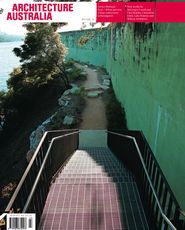Reconciliation
In late 2009, the Australian Institute of Architects’ Victorian Chapter announced its intention to form a Reconciliation Committee. The chapter is to be congratulated for taking up this important challenge. It is a noble endeavour that can succeed with the right attitude.
I am currently of the opinion that the prevailing attitudes of some of my colleagues are yet to mature into a formidable foundation to enable change, the real measure of reconciliation. This is as much a national problem as it is a regional one. However, my recent dealings with leading members of this specific chapter lead me to claim that there exists a sizeable risk to success. There are three occasions that lead me to this conclusion.
The first occasion was in late 2007, when Merrima Design + tUG Workshop were unanimously awarded the 2008 Creative Directorship of the Venice Biennale by the RAIA’s Venice Biennale Committee to mount “Finding Country”. Two weeks after a contentious start-up meeting, I received an email from the committee chairman stating that the Institute would not proceed with our team’s entry as the relationship lacked mutual respect. Indeed. The subsequently appointed team would proceed with a curatorial line that celebrated a 200-year history of architecture in this country, tracing: “the threads that connect the past 200 years of European settlement with current practice while providing an historical context for today’s strands of thinking.” [See “Abundance”, media kit, 28 July 2008.] This approach demonstrated an inability to engage with an indigenous voice – particularly on intellectual terms. The Monthly’s Robert Manne recently identified this exact issue as a significant failing of historian Keith Windschuttle’s asymmetrical version of Australian history.
The second occasion was during the 2008 National Indigenous Housing Conference at which I was speaking. This event remains one of the highlights of my time as an architect and an indigene. It was special because the think tank guiding this event was a group of indigenous and non-indigenous architects with impressive expertise on the matter of housing in indigenous communities. All understood the current indigenous condition and the need for skin in the game, though the social capital it built was not extended to advocacy. Instead, the media face and voice of the conference was the then RAIA Immediate Past President. Cape York leader Noel Pearson has written of the citizen’s three roles – private, public and voluntary – and how in functioning communities each of these three spheres thrive. In this instance, public and private interests were not sufficiently adjusted to accommodate the forward synergy of a voluntary expert group.
The third occasion is recent and is connected directly to the process the Victorian Chapter is currently undergoing to select a Reconciliation Committee. Shortly after the call for applications, I wrote a reference for a worthy applicant. After much enquiry, a tardy email from the committee chairman was sent to my candidate. It stated that due to the number of applications, he did not make the cut. This is sloppy evaluation by any standard. If the quality and experience of the applicants do not take precedence in the making of something so important, the underlying message is unmistakable: on one hand “we are here to help the victims” and on the other “we know better than them”. This literally translates as moral vanity on one hand, and denial on the other. Pearson eloquently describes these as the “political left and right positions of racism” respectively. The presence of this attitude is most dangerous.
In historical terms, and particularly since 1967, our profession has expressed a will to engage with indigenous communities, but failed to build any momentum. The legitimacy of the Victorian Chapter’s Reconciliation Committee is fast approaching a crossroads. Irrespective of its final membership, the committee will need to conduct itself in three ways to get it right. Firstly, the committee must engage the local Victorian Aboriginal community in a symmetrical partnership. Secondly, each member acting in a voluntary role must advance those responsibilities he or she best holds against the current of private and public interests. And thirdly, each member must reject the two hands of racism in negotiating a way forward with the Victorian Aboriginal community.
Reconciliation is a complex process of negotiation that is bound to symmetrical engagement. It requires people to get behind the idea – not in front of it.
Kevin O’Brien, architect.















